


Caption: The Sun in visible light with sunspots including a rare spiral one.
Credit/Permission: NSO/AURA/NSF, © NOAO/AURA, 1982 / NOAO/AURA Image Library Conditions of Use.
Download site: NASA Image Gallery: White light, February 19th 1982.
Supplementary Lab Preparation: The items are often alternatives to the required preparation.
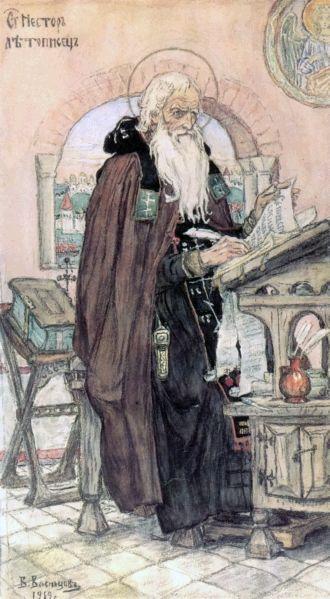
Caption: St. Nestor the Chronicler (c. 1056--c. 1114), St. Vladimir's Cathedral, Kiev, Ukraine.
At his studies.
Credit/Permission: Viktor Vasnetsov (1848--1926), 1919 (uploaded to Wikipedia by User:Butko, 2006) / Public domain.
Image linked to Wikipedia.
The quiz might be omitted if it's not feasible or convenient. The students may or may not be informed ahead of time of quiz omission depending on the circumstances.
The quizzes in total are 40 % of the course grade. However, only the top five quiz marks are counted.
In preparing for a quiz, go over the Required Lab Preparation.
The Supplementary Lab Preparation (see above) could help, but is only suggested if you feel you need more than the required Required Lab Preparation.
There is no end to the studying you can do, but it is only a short quiz.
One to two hours prep should suffice.
There will be 10 or so questions and the time will be 10 or so minutes.
The questions will range from quite easy to challenging.
The solutions might be posted at Sunspots: Quiz Solutions after the quiz is given. Whether they are or not depends on the circumstances of each individual semester.
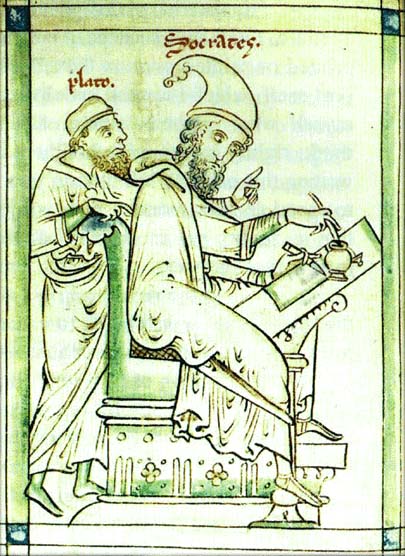
Caption: Plato (428/427--348/347 BCE) and Socrates (circa 469--399 BCE) in a Medieval image.
Here the disciple seems to be instructing the master/mentor using the Socratic method.
The basic pose is much like in intro labs.
Credit/Permission: Medieval artist, Middle Ages (probably 1000--1400) (uploaded to Wikipedia by User:Tomisti, 2007) / Public domain.
Image linked to Wikipedia.
There are all kinds of little finicky things about the controls to remember.
In situ, you can always run to other instructors for help with showstopper.
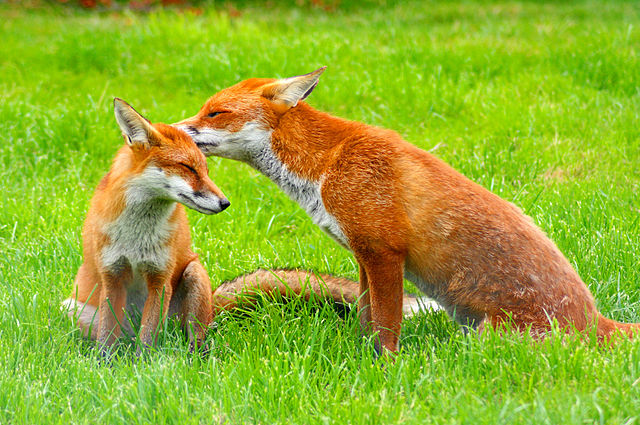
Caption: "Red foxes (Vulpes vulpes) at the British Wildlife Centre, Horne, Surrey, England." (Slightly edited.)
Credit/Permission: © Keven Law, Photo 2008 Aug17 / Creative Commons CC BY-SA 2.0.
Image linked to Wikipedia.
Sunspots were occasionally recorded thereafter without their existence becoming common knowledge (Wikipedia: Sunspots: Early observations; J.M. Vaquero, 2007, astro-ph, Historical Sunspot Observations: A Review).
The early, occasional observations were probably mostly done when there was a large sunspot and the Sun was very close to the horizon (i.e., at sunrise and sunset) so that its intensity was strongly reduced by the thicker air mass at those times or when the Sun was viewed through smoke or mist.

Caption: Pinhole projection.
Actually this figure is incorrect for partial solar eclipse since the Moon really gives convex bite, not a concave bite as in the figure.
Eventually, pinhole projection (see also Wikipedia: Camera obscura) was used for safe observation. This seems to have been after the discovery of the telescope.
Pinhole projection uses an opaque covering with a small aperature that allows pinhole projection on a background screen.
A point inverted image of the object is cast on the screen. Pinhole projection is easily understood using light ray tracing.
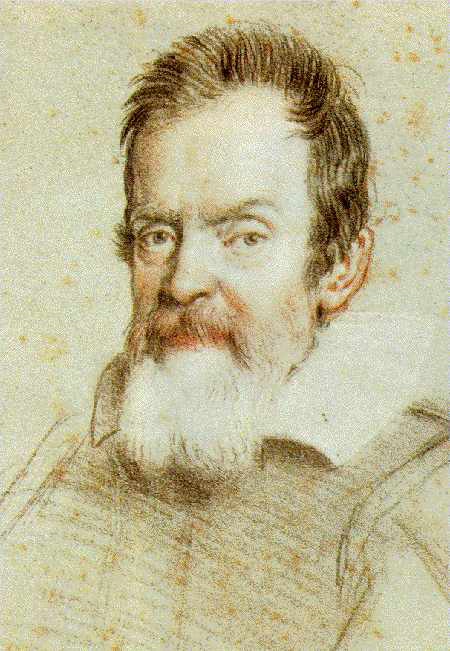
Caption: Galileo Galilei (1564--1642). Portrait in crayon by Ottavio Leoni (1578--1630).
Credit/Permission: Ottavio Leoni (1578--1630), 1624 (uploaded to by User:Pseudomoi, 2005) / Public domain.
Image linked to Wikipedia.
Benedetto Castelli (1578--1643), a protege of Galileo, developed a projection technique for the telescope to allow safe observation of the Sun at any time (see The Galileo Project: Sunspots (scroll down about 50 % or search on "Castelli")).
Castelli's setup may have been a lot like the one in the figure below---without the wife and kids---he was a monk.
The Sun is a sphere of gas, and not a solid sphere.
Sphere of gas and
liquid
can have differential rotation
and non-rotational motions like
convection and oscillations.
The Sun (a sphere of gas)
exhibits
differential rotation and other
non-rotational motions like convection
and oscillions.
The Earth, is in fact,
not entirely a solid sphere.
The outer core
(2890--5150 km from the center)
is liquid (primarily
molten iron
and nickel)
(see Wikipedia: Structure of the Earth).
The outer core probably exhibits
both differential rotation
and convection.
The figure below illustrates the current
understanding of the overall solar rotation.
Caption: Internal-to-solar photosphere
solar rotation for
solar latitudes 0, 15, 30, 45, and 60 degrees.
The horizontal axis is radius in units of the
solar radius:
This value may be a mean value: the sources are a bit unclear.
It is sort of the radius of the
solar photosphere---but the
solar photosphere is usually
defined to be a thin layer, and so it is NOT clear to yours truly what the
given value is exactly.
To convert the plotted frequencies to
sidereal period (i.e.,
period relative
to the nearly inertial frame
of the fixed stars) in days
use the following formula:
where f_nHz is frequency in nanohertz and
435 nHz is a fiducial value for the internal
solar rotation as the
plot itself shows.
The formula values obtained by casual inspection of the plot are
probably not so good
The plot gives a 0 degrees latitude surface
sidereal period of 25.9 days,
but the measured value is 24.47 days
(see
Wikipedia: Solar rotation: Sidereal rotation;
Jurgen Giesen plot).
The plot gives 31.3 days for 60 degrees latitude surface
sidereal period.
The measured value is more like 30.2 days
(see Jurgen Giesen plot).
But maybe the plot is meant to be extrapolated to the surface.
The observed 90 degrees latitude limit surface
sidereal period
is about 34 days
(see
Wikipedia: Solar rotation:
Using sunspots to measure rotation period with a conversion
from synodic period
to sidereal period;
Jurgen Giesen plot)
The plot clearly shows the
differential rotation of the
Sun.
Remarkably, the rotation rate inward of about 0.65 R_☉ is nearly constant---the curves
for the different solar latitudes converge to a nearly constant value of about 435 nHz.
This means this region rotates nearly as if it were a solid sphere even though
it is a sphere of gas.
The radius 0.65 R_☉ approximately divides the
inner solar radiative zone
from the outer
solar convective zone.
The transition between these two zones is the
tachocline.
Credit/Permission:
© Global Oscillation Network Group (GONG),
2008
(uploaded to Wikipedia
by User:KeepOpera,
2010) /
Creative Commons
CC BY-SA 3.0.
Image linked to Wikipedia.
One of the "discoveries" of Lab 9 is that
solar rotation
this differential rotation:
i.e., parts rotate at different rates.

1 R_☉ = 6.955*10**8 m = 0.0046491
astronomical units (AUs).
The vertical axis is
frequency f=Ω/(2π)
measured in nanohertz (1 nHz=10**(-9) Hz).
29.7888 ... days
p = ------------------
f_nHz/435 nHz
30 days
≅ --------------- ,
f_nHz/435 nHz

Caption: Click on the Alien image to see the Jurgen Giesen solar rotation plot.
Credit/Permission: © David Jeffery / Own work.
The prime meridian of heliographic coordinate system is just "the north-south centerline on the visible solar disk" (Coordinate System: Center for Integrated Space Weather Modeling (CISM)).
This prime meridian is always moving because of the solar rotation and the Earth orbital motion.
The solar longitude is negative/positive to the Sun's west/east (east/west on the sky).
Given that the Sun has no permanent surface features, the solar longitude defined as above seems to be convenient.
Then 360 degrees over that synodic rotation rate gives the synodic period.
What is synodic period?
It is the period as measured from Earth.
But the Earth is moving relative to the nearly inertial frame of the fixed stars.
So the synodic period is not the true physical period---which is the sidereal period (i.e., period relative to the nearly inertial frame of the fixed stars).
The conversion formulae between the two kinds of periods is simple as long as we neglect the fact that the Sun's axis is inclined to the ecliptic plane by 7.25 degrees: i.e., we assume zero inclination.
There is an object orbiting the Sun: it could be a planet or a sunspots.
The object is rotating with rotation rate R and the Earth with rotation rate R_⊕.
By definition, one synodic period p_syn later, the object is back on the Earth-Sun line.
The object has lapped the Earth, and so is now 360 degrees ahead of the Earth.
Thus, we must have
R*p_syn= R_⊕*p_syn + 360 ,
where R is the Sun's rotation rate---it's sidereal rotation rate.
Now R=360/p and R_⊕=360/p_⊕, where
p is the object's rotational sidereal period
and
p_⊕ is the Earth's orbital sidereal period.
So, skipping obvious algebra, we get
1/p=1/p_⊕+1/p_syn .
We rearrange this into the convenient conversion formulae
p=p_syn/(1+p_syn/p_⊕)=p_syn/(1+p_syn/365.25)
and
p_syn=p/(1-p/p_⊕)=p/(1-p/365.25) ,
where we have approximated the Earth's orbital sidereal period
by the Julian year of exactly 365.25 days.
The formula for p is the one of interest for this lab since we measure p_syn directly and have to calculate p.
The formula for p has some interesting features as a function:
As an exmaple calculation with the formula for p, say we measure p_syn=25.00 days, then p=25.00/(1+25.00/365.25)=23.40 days.
And that is the whole story for sidereal period and synodic period.
This sunspot is the only significant one at a latitude as high as this on the Sun in our data set.
The Australian site has the actual sunspot number data for 2002 that is needed to answer one of the question on sunspot number.
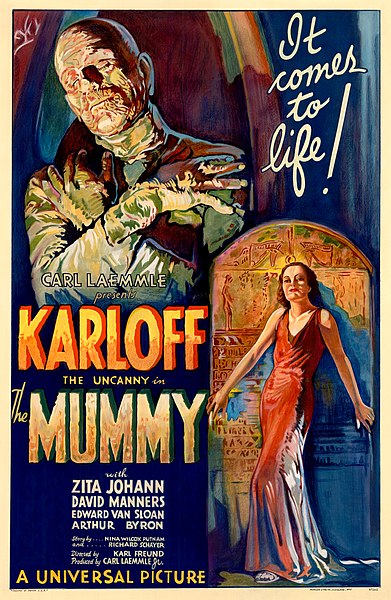
Below are some generic comments for Lab 9: Sunspots that may often apply.

Caption: Film poster for the TheMummy (1932) starring Boris Karloff (1887--1969).
Credit/Permission: Employee or employees of Universal Pictures attributed to Karoly Grosz (fl. 1930s), 1932 (uploaded to Wikipedia by User:Crisco 1492, 2012) / Public domain.
Image linked to Wikipedia.
Any that are semester-section-specific will have to added as needed.
The definitions required for the reports are those that are relevant to astronomy and NOT other topics.
The links given with the lab keywords in Required Lab Preparation are usually better sources than just googling for a term definition. Often googling will lead to the plain wrong definition or a definition by a person who doesn't really understand the term themself and is just paraphrasing someone else's definition.
Sentences begin with a capital letter letter and end with a period. Usually there is a subject and a verb. Not always.
Since you are working in groups, you should have different group members read over the sentence answers to see if they are correct and comprehensible. Read them out loud.
Usually it is obvious what those questions are. Sometimes maybe not. Err on the side yes an explanation is needed.